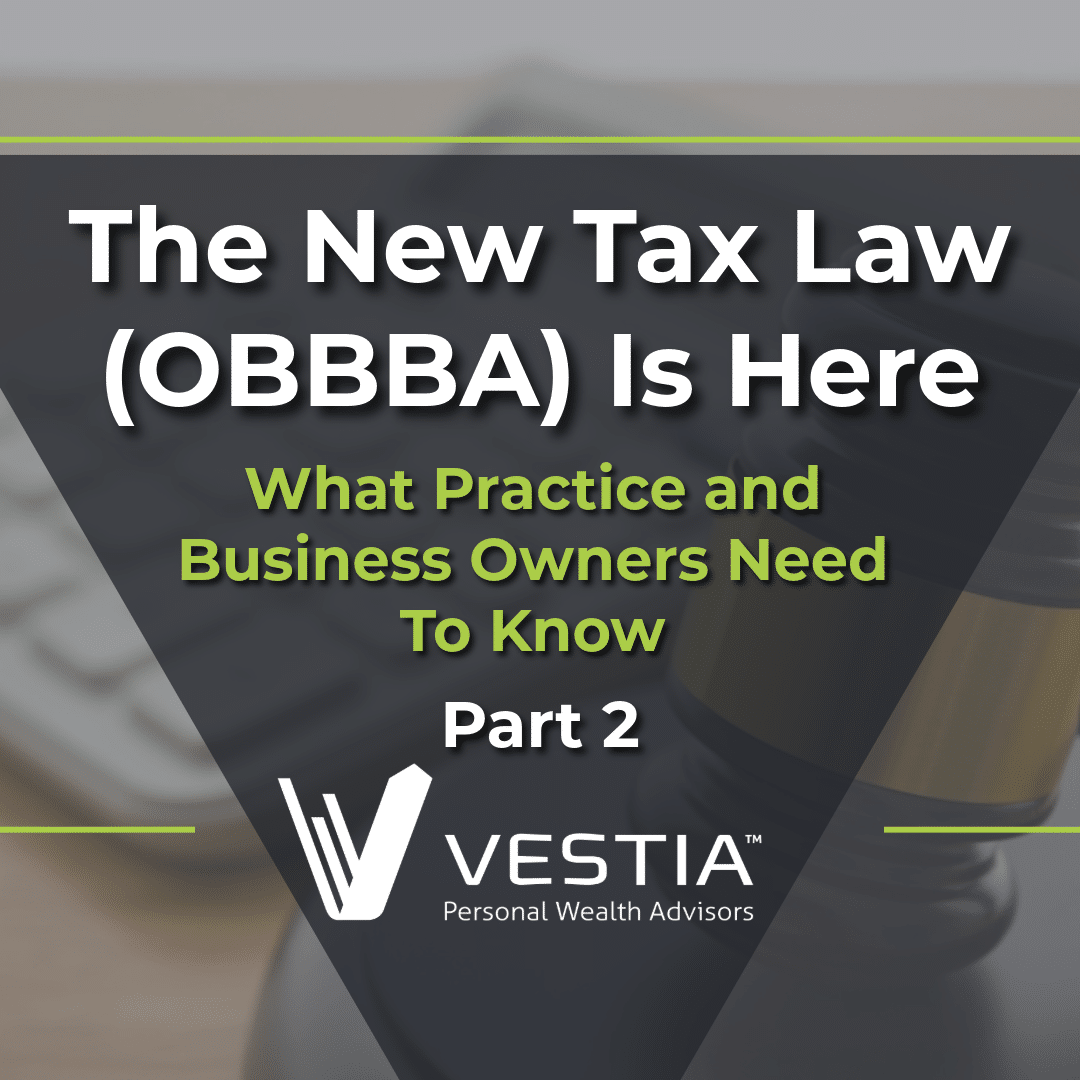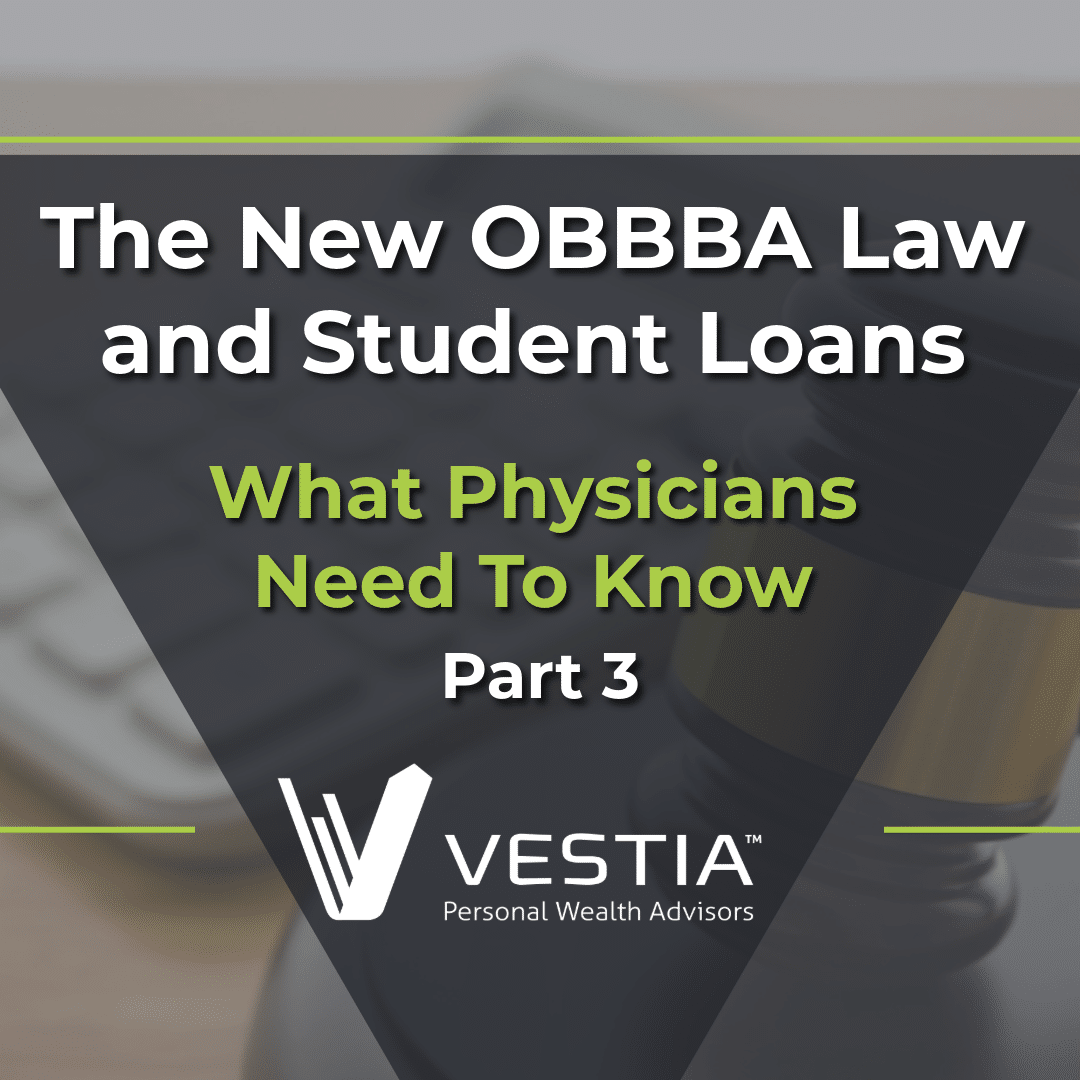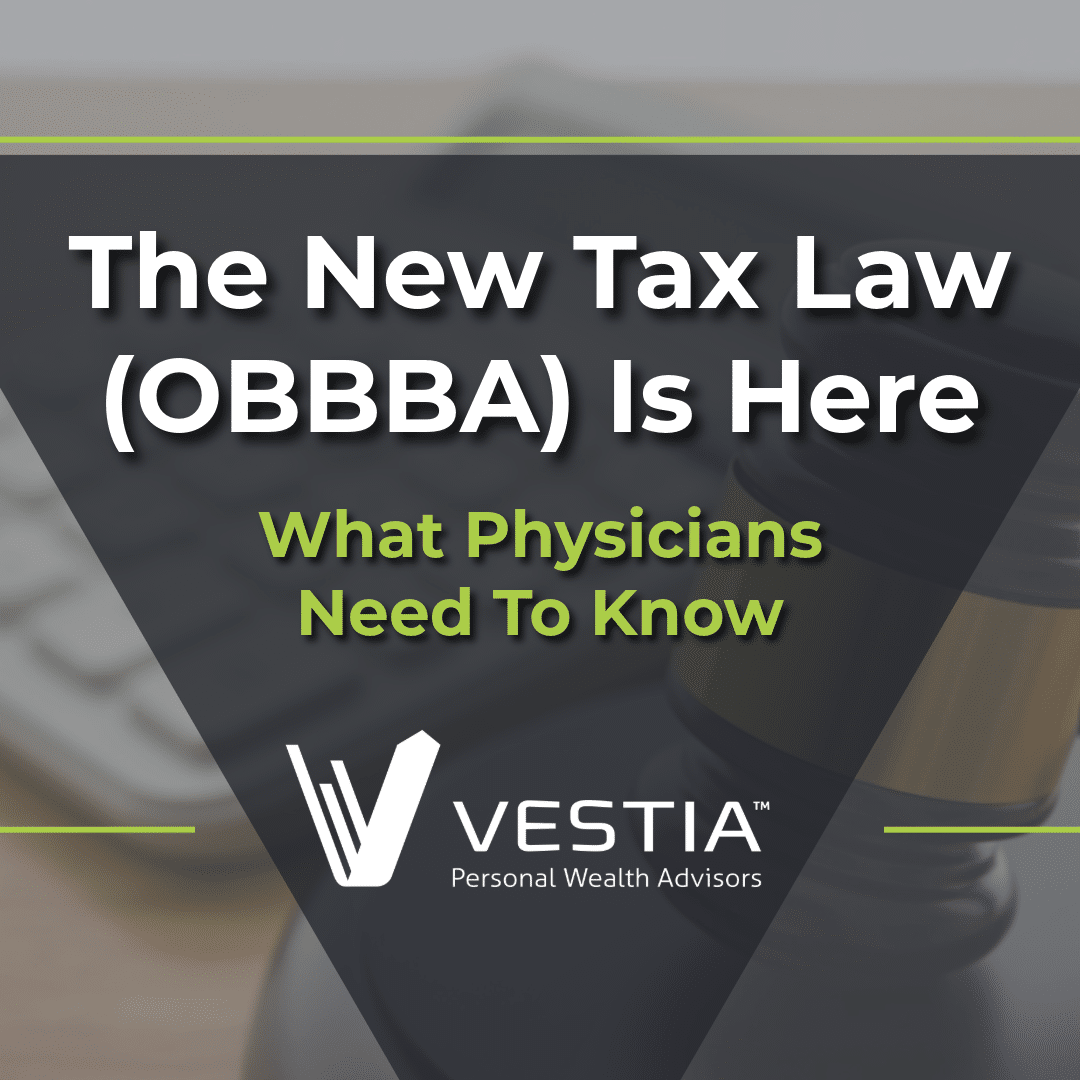The One Big Beautiful Bill for America (OBBBA) was signed into law earlier this month, and because there are so many items to cover, we’re breaking our analysis into a three-part series:
- Part 1: Personal income tax changes that affect physician households (See previous blog post in case you missed it!)
- Part 2 (this article): Changes impacting medical practices and physician-owned businesses
- Part 3: Updates to student loans and repayment strategy considerations. (Coming Soon!)
As part of our ongoing analysis, we’re now turning our attention to how the new law impacts physician-owned businesses and medical practices. Because we specialize in working with physicians, we’ve been closely reviewing which tax provisions will affect practice owners, partners, and those with side businesses like consulting, real estate, or private investments. Just like with personal taxes, most of the significant changes take effect in 2026, giving us some time to plan. For physicians who own a business or have complex investment structures, the provisions in this part of the bill may carry even greater financial implications than the personal tax changes.
Since the bill spans more than 1,000 pages, we’re not covering every detail here. Instead, this is a high-level overview of the provisions most broadly applicable to medical practices.
Please Note: We are not accountants. We collaborate closely with trusted CPAs and tax professionals, but this article is for informational purposes only and not intended to provide tax advice.
We received great feedback that the definition section of the last article was helpful, so we thought it would be helpful to recap some business tax terminology as well (if you’re already familiar with tax terminology, feel free to scroll past this section!)
- Depreciation spreads out the cost of a long-term business asset over its useful life for tax deduction purposes. The IRS generally doesn’t let you deduct the full cost all at once if the asset will benefit your business for many years.
Example: If your practice buys a $50,000 X-ray machine expected to last 5 years, you might deduct $10,000 per year on your taxes over 5 years. - Accelerated Depreciation lets you take larger deductions in the earlier years of an asset’s life, rather than evenly spreading it out.
Example: Instead of $10,000 per year for 5 years, you might deduct $20,000 in year 1 and smaller amounts in later years. - Bonus Depreciation allows you to deduct a large portion (sometimes 100%) of an asset’s cost immediately in the year it’s placed in service.
Example: Buy $100,000 of equipment and, if bonus depreciation is 60%, you can deduct $60,000 right away. - A cost segregation study breaks down a building rental or commercial property purchase, expansion or remodel into components (like fixtures, electrical, plumbing). Without a study, the IRS assumes everything in a commercial property (like a medical office) must be depreciated over 39 years. But many parts of the building qualify for 5, 7, or 15-year depreciation.
Example: A physician buys a $1 million office building, and a cost segregation study might identify $200,000 in assets that can be depreciated over 5–15 years instead of 39. The physician accelerates depreciation on those components to free up cash flow in early years of ownership. - QBI (Qualified Business Income Deduction) is a 20% tax deduction on qualified income from pass-through entities like S-Corps and partnerships but it phases out for high earners.
Example: If you own a practice and earn $300,000 in qualified income, you could deduct up to $60,000 (20% of $300,000 – unless phased out). - PTET (Pass-Through Entity Tax Election) allows owners of pass-through businesses (like S-Corps or partnerships) to pay state income taxes at the entity level instead of on their personal return, helping them work around the $10,000 State and Local Tax (SALT) deduction cap on federal taxes.
Example: If your medical practice earns $500,000 and pays $30,000 in state income tax through the PTET election, that full $30,000 becomes a federal tax deduction at the business level rather than being limited to $10,000 on your personal return.
Now that you’re oriented to the terminology, here’s what you need to know about the OBBBA as it applies to business taxes:
- Businesses can claim 100% bonus depreciation on property acquired on or after 1/20/2025 and this will continue indefinitely. This was previously set to decrease to 20% in 2026 and be eliminated in 2027, so this is a big change! If you have been considering a capital investment, this will be a great environment to invest in high-cost assets like medical office buildings and surgery centers from a tax perspective. The prior 40% bonus depreciation still applies for property acquired 1/2/2025 – 1/19/2025 and you can elect to still use the prior 40% rate for the next tax year.
Note: We do expect there will be an increased demand for cost segregation studies as businesses and real estate investors look to take advantage of the opportunity to accelerate depreciation under the OBBBA provisions. There will likely be an increase in companies marketing this service and we’d encourage you to work with a credible company with an existing track record. Connect with your financial team sooner rather than later if you think you could benefit from these new provisions!
- Businesses with domestic research and development costs previously had to spread those costs over 5 years for deductions. Beginning in 2025, businesses can immediately deduct these costs. Small businesses (defined as $31 million or less or revenue) can elect to claim this immediate deductibility retroactive to 2022 by filing amended returns prior to 7/4/2026.
- The QBI deduction, initially set to expire in 2026, was extended indefinitely at 20%. Many physicians are excluded from this either because they are defined as a specified service business or because they make enough income to be phased out ($440k married filing joint,
- A commonly used strategy for physicians since the Tax Cuts and Jobs Act of 2017 has been to use the PTET deduction as a replacement of sorts for this QBI deduction and a way around the $10k cap on State and Local Tax (SALT) deduction. The OBBBA makes no changes to the PTET deduction or what types of businesses/ taxpayers can make state PTET elections. There were earlier versions of the bill that would have excluded physicians from this deduction as a specified service business, and we are glad this didn’t make it into the final legislation!
- For Qualified Small Business Stock (QSBS), the 100% capital gains exclusion still applies if you hold the stock for 5+ years but now you can also get a 50% exclusion after 3 years and 75% exclusion after 4 years. The gain exclusion cap is increased to the greater of $15 million or 10x your investment, and the asset limit for companies that qualify has increased to $75 million.
- The threshold for Form 1099-NEC and Form 1099-MISC to report payments made to service providers and vendors was increased from $600 to $2,000 starting in 2026 and will be indexed for inflation moving forward.
Staying educated on tax changes empowers you to make intentional, proactive choices for your practice. With the remainder of the year ahead, there’s still time to evaluate how the tax law changes under OBBBA may impact your practice or business ownership, and whether strategic moves in 2025 could help you take full advantage of current provisions before they expire.
If you have specific questions about how any of the business provisions in the bill may apply to you, don’t hesitate to reach out to your advisory team. As always, we are here to help!


